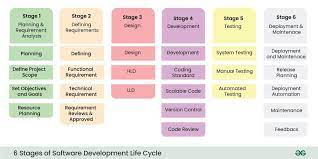The Application Development Life Cycle
Application development is a complex process that involves several stages known as the Application Development Life Cycle (ADLC). This cycle consists of various phases that are crucial for the successful creation and deployment of applications.
Planning
The first phase of the ADLC is planning. This is where the project scope, requirements, and objectives are defined. It involves gathering information, analyzing feasibility, and creating a roadmap for the development process.
Design
Once the planning phase is complete, the design phase begins. This is where developers create a blueprint of how the application will look and function. User interface design, database design, and system architecture are key components of this phase.
Development
In the development phase, actual coding takes place based on the design specifications. Developers write code using programming languages and frameworks to build the application’s functionality according to the requirements outlined in earlier stages.
Testing
After development is complete, rigorous testing is conducted to identify bugs and ensure that the application functions as intended. Testing involves various techniques such as unit testing, integration testing, and user acceptance testing to validate the application’s performance.
Deployment
Once testing is successful, the application is ready for deployment. Deployment involves releasing the application to users or clients through various channels such as app stores or web servers. It also includes maintenance and support to address any issues that may arise post-deployment.
Maintenance
The final phase of the ADLC is maintenance, where developers monitor and update the application to ensure its continued functionality and performance over time. Regular updates, bug fixes, and enhancements are part of this ongoing process to meet evolving user needs.
In conclusion, understanding and following the Application Development Life Cycle is essential for delivering high-quality applications that meet user requirements and business goals effectively.
Understanding the Application Development Life Cycle: Key Phases, Importance of Planning, Design Significance, Programming Tools, Testing Types, Deployment Strategies, Maintenance, and Quality Enhancement
- What is the Application Development Life Cycle (ADLC)?
- What are the key phases of the Application Development Life Cycle?
- Why is planning important in the application development life cycle?
- How does design play a crucial role in application development?
- What programming languages and frameworks are commonly used in the development phase?
- What types of testing are conducted during the application development life cycle?
- How is an application deployed to users or clients?
- What is involved in maintaining an application post-deployment?
- How can following the ADLC improve the quality of developed applications?
What is the Application Development Life Cycle (ADLC)?
The Application Development Life Cycle (ADLC) refers to the structured process that software developers follow to create and deploy applications successfully. It encompasses a series of phases, including planning, design, development, testing, deployment, and maintenance. Each stage in the ADLC plays a crucial role in ensuring that the application meets user requirements and functions effectively. By following the ADLC, developers can streamline the development process, identify potential issues early on, and deliver high-quality applications that align with business objectives.
What are the key phases of the Application Development Life Cycle?
One of the most frequently asked questions regarding the Application Development Life Cycle is about its key phases. The ADLC typically consists of several essential stages that are crucial for the successful development and deployment of applications. These key phases include planning, design, development, testing, deployment, and maintenance. Each phase plays a significant role in ensuring that the application is created efficiently, functions properly, meets user requirements, and remains sustainable over time. By understanding and following these key phases of the ADLC, developers can streamline the development process and deliver high-quality applications that align with business objectives and user needs.
Why is planning important in the application development life cycle?
Planning is a crucial phase in the application development life cycle because it lays the foundation for the entire project. Effective planning helps define the project scope, objectives, and requirements, setting clear goals for the development team to achieve. By outlining a roadmap and identifying potential risks and challenges early on, planning minimizes uncertainties and ensures that resources are allocated efficiently. It also facilitates better communication among team members and stakeholders, leading to a smoother development process and ultimately a successful application that meets user needs and business objectives.
How does design play a crucial role in application development?
Design plays a crucial role in application development as it serves as the blueprint for how the application will look and function. A well-thought-out design ensures that the user interface is intuitive, visually appealing, and easy to navigate, enhancing the overall user experience. Additionally, a solid design helps developers understand the structure and flow of the application, making the development process more efficient and reducing the likelihood of errors or rework later on. By focusing on design early in the application development life cycle, developers can create a product that not only meets user needs but also aligns with business objectives, ultimately leading to a successful and impactful application.
What programming languages and frameworks are commonly used in the development phase?
During the development phase of the application development life cycle, developers commonly use a variety of programming languages and frameworks to build the application’s functionality. Some of the most commonly used programming languages include JavaScript, Python, Java, C#, and Ruby. These languages offer different features and capabilities that cater to various development needs. In addition to programming languages, developers often rely on popular frameworks such as React, Angular, Node.js, Django, and .NET to streamline the development process and enhance efficiency. By leveraging these languages and frameworks effectively, developers can create robust and scalable applications that meet the requirements outlined in earlier stages of the ADLC.
What types of testing are conducted during the application development life cycle?
During the application development life cycle, various types of testing are conducted to ensure the quality and functionality of the application. These include unit testing, which focuses on testing individual components or modules of the application to validate their behavior; integration testing, which tests how different modules work together as a whole system; system testing, which evaluates the entire application’s functionality in a real-world environment; user acceptance testing, where end users validate that the application meets their requirements; and performance testing, which assesses how well the application performs under different conditions. Each type of testing plays a crucial role in identifying and addressing issues throughout the development process to deliver a reliable and high-quality application to users.
How is an application deployed to users or clients?
During the deployment phase of the application development life cycle, the process of releasing the application to users or clients takes place. Deployment involves various steps such as packaging the application, configuring servers or app stores for distribution, and ensuring a smooth transition from development to production environments. Once the application is thoroughly tested and approved for release, it is made accessible to users through app stores, web servers, or other distribution channels. Continuous monitoring and support are crucial post-deployment to address any issues promptly and ensure a seamless user experience. Deploying an application successfully requires careful planning, coordination, and adherence to best practices to ensure a smooth and efficient rollout for end-users.
What is involved in maintaining an application post-deployment?
Maintaining an application post-deployment involves a series of crucial tasks to ensure its continued functionality and performance. These tasks include monitoring the application for any issues or bugs that may arise, implementing regular updates to address security vulnerabilities and improve features, providing technical support to users to troubleshoot any problems they encounter, and optimizing the application for better performance based on user feedback and usage data. Additionally, maintaining an application post-deployment also involves ensuring compatibility with new operating systems or devices, scaling the application to accommodate growth in user base or data volume, and adhering to industry standards and regulations for data privacy and security. Overall, effective maintenance post-deployment is essential for maximizing the longevity and success of an application in meeting user needs and business objectives.
How can following the ADLC improve the quality of developed applications?
Following the Application Development Life Cycle (ADLC) can significantly enhance the quality of developed applications by providing a structured approach that ensures all critical stages of development are properly addressed. By following the ADLC, developers can thoroughly plan, design, develop, test, deploy, and maintain applications in a systematic manner. This helps in identifying and addressing issues early in the process, leading to fewer bugs and errors in the final product. Additionally, adherence to the ADLC allows for better collaboration among team members, clear communication of project requirements, and efficient management of resources throughout the development lifecycle. Ultimately, following the ADLC results in higher quality applications that meet user expectations and business objectives effectively.




